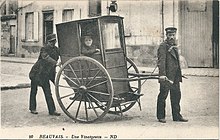Everything you need to know about the pedicab
Before talking about the current characteristics of the pedicab, we must go back to its history and its origins.
Origins of the pedicab :
It is in France, in the 17th century that the first comparisons are possible. Indeed, at that time, the bicycle did not yet exist and travel was done in private or collective horse-drawn carriages. However, in 1679, the first omnibuses were stopped creating a strong demand in terms of public transport. The first rickshaw-type vehicles were therefore invented. Called “vinaigrettes” in reference to the itinerant traders of vinegar, this vehicle is composed of 2 wheels and generally moved by two people (one pulling at the front and the other pushing at the back).


The term rickshaw originated in Japan from 1869 (人力車, 人 jin = human, 力 riki = power or force, 車 sha = vehicle) and quickly developed in Asia to become the main mode of transport. Indeed, at the time the human cost was cheaper than that of horses, the latter being generally used only by the military.
In the same period, the bicycle began to gain in stature, but this mainly in Europe because the fact of moving by one's own means was socially difficult to accept in Asia.
Evolution of the pedicab:
It was therefore during the 20th century that we find developments in this mode of transport with the creation of the pedicab (known in other countries as bike taxi, cycle rickshaw, pedicab, bikecab, cyclo, beca , becak, trisikad, sikad, tricycle taxi, trishaw, or hatchback bike). First appearing in Singapore in 1929, the pedicab is gradually replacing rickshaws in Asia, Africa and Europe.
The success of the pedicab in France takes place at the end of the German occupation during the Second World War to replace taxis due to the shortage and the price of fuel.
In 1980, the number of pedicab was estimated at more than 4 million in the world!
We must distinguish the pedicab from the auto-rickshaw (known in other countries as baby taxi, mototaxi, pigeon, jonnybee, bajaj, chand gari, lapa, tuk-tuk, tum-tum, Keke-napep, Maruwa, 3wheel, pragya, bao-bao, easy bike, and tukxi). The latter, initially created for logistics in the middle of the 20th century, is used for the transport of people at the beginning of the 21st century. Inspired by the moped, the pedicab is equipped with a motor and present on continents all over the world.
Unlike the tuk-tuk, the pedicab does not have a motor and is mainly propelled by pedaling and muscle power. Modern versions of the pedicab are often equipped with electric pedal assistance that complies with European regulations for electric bicycles.
Example of the Turtle pedicab :
Consisting of three wheels (one at the front and two at the rear), there is a front space dedicated to the driver and the pedaling system, then a rear space dedicated to passengers and battery storage. The cockpit of the pedicab and its equipment provide protection against wind and rain as well as passenger safety throughout their journey. The structure is made of recyclable materials. Some pedicabs like Turtle have motorcycle parts to enhance the reliability of certain wear parts.
Today, the pedicab is considered to be the most ecological and suitable means of transport in urban areas thanks to the rapidly developing cycling infrastructure. Its use is increasingly important, following the example of Germany.
Turtle combines the next generation of pedicabs with new technologies to order a ride from a mobile application, a first in the sector.
Definition of the pedicab
The pedicab is a vehicle intended for the transport of people with driver. Equipped with three wheels and an electrically assisted motor, the pedicab has the same purpose as that of a taxi or a VTC, namely to go from point A to point B. Generally pedicabs comply with the regulations allowing them to ride on cycle paths and bus lanes, giving them a definite advantage in urban areas.
Pedicab development :
For several decades, the consequences of global warming have been felt. It is now essential to act to slow down or even reduce our impact!
Road transport is one of the challenges of the ecological transition because it represents nearly ¼ of CO2 emissions in France. Urban areas, with the greatest concentrations of air pollution and noise pollution, must act and change the way we move. The whole car no longer makes sense, we must make way for soft mobility.
Self-service bicycles and scooters contribute to this but unfortunately have a low rate of use compared to vehicles with drivers or public transport.
So if the pedicab was the right balance between soft means of transport and a transport service with driver? 100 times less polluting than a thermal car and 10 times less polluting than an electric car, the pedicab is perfectly suited to the city.
In addition to being more ecological, the pedicab has many advantages.
Cycling infrastructure often allows the pedicabs to be as fast or even faster than the car and the manufacturing and use costs are much lower than the car allowing it to travel cheaper.
Our bet is to make the pedicabs the means of transport that will replace taxi and VTC vehicles in urban areas (it is important to specify this, because it does not apply everywhere).
Legal framework of the pedicab:
There are many pedicabs working independently all over the world with an activity mainly or even exclusively oriented towards tourism. The pedicab does not yet have specific regulations for its activity. Thus some cheat on the conformity of their pedicab. This damages the image of the service and the sector. Building a legal framework for the pedicab business is one of our objectives.